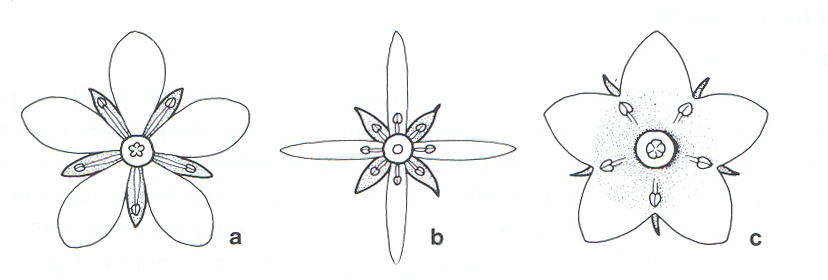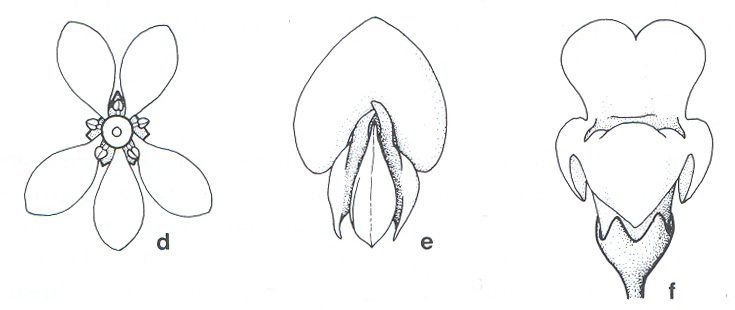In many keys it is necessary to determine the symmetry of flowers. This web site aims to reduce the possible problems in determining symmetry with the aid of notes, images and a test.
Select from the following aspects of floral symmetry to view notes and high quality images depicting the various features. When you are ready, test your understanding and take the Floral Symmetry quiz (see note below).
Floral symmetry refers to if, and how, flowers can be divided in mirror-image parts.
When deciding on the symmetry of a flower, the position and shape of the more conspicuous features are considered, i.e. the petals or perianth and/or the androecium.
Actinomorphic or radial (or regular) - also known as polysymmetric.
Slideshow of Actinomorphic symmetry
Divisible through the centre of the flower in several or many longitudinal planes, the halves of the flower being mirror images in every case.

Illustration from Clarke, I. & Lee, H. (2003) Name that Flower, Melbourne University Press, Victoria.
Slideshow of Zygomorphic symmetry
Zygomorphic or bilateral (or irregular) - also known as monosymmetric.

Illustration from Clarke, I. & Lee, H. (2003) Name that Flower, Melbourne University Press, Victoria.
A small number of species have flowers with no plane of symmetry.
The flowers of a few species have no plane of symmetry and are asymmetrical (a term that is applied by some authors to zygomorphic flowers). The flowers of some cannas and some gingers are classified in this manner.
While the flowers of most species can be easily classified as actinomorphic or zygomorphic it should be remembered there is not necessarily a clear-cut distinction between the two.
Some flowers are perfectly symmetrical and there are some very distinctive forms of zygomorphic flowers. In between there are some flowers where it can be hard to choose between the two. Most mistakes are probably made with flowers that have several free petals and the petals are relatively long and have a small point of attachment to the receptacle. In this case the petals can be pushed out of position and thus the flower appears slightly zygomorphic when it is actually actinomorphic
View images that illustrate this

In floral formulae various symbols have been used to show symmetry. Below are some of the alternatives:
NOTE: Allow popups from science-health.csu.edu.au in your browser to open the Floral Symmetry test.
Then return to this page retry the test button.
This web site is not an in-depth analysis of floral symmetry. It is purely designed to help users of dichotomous keys make the choice between actinomorphic and zygomorphic. For more academic detail see papers such as Endress, PK (1999) Symmetry in flowers: diversity and evolution. Int. J. Plant Sci. 160 (6 Suppl.): S3-S23.